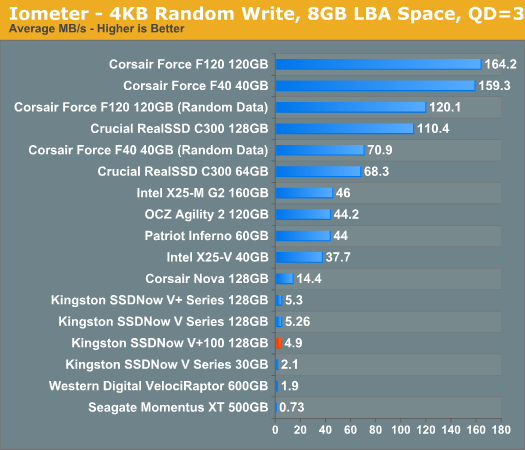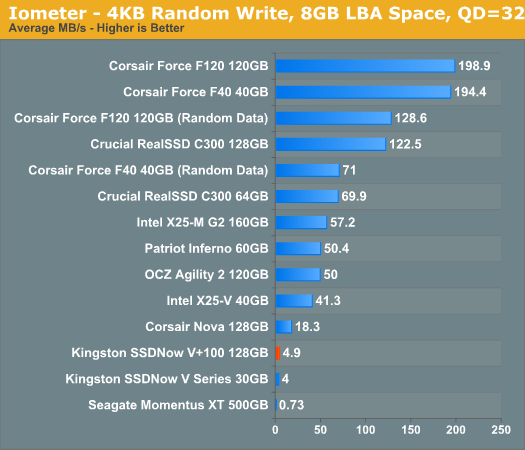Kingston SSDNow V+100 Review
by Anand Lal Shimpi on November 11, 2010 3:05 AM EST- Posted in
- Storage
- SSDs
- Kingston
- SSDNow V+100
Random Read/Write Speed
The four corners of SSD performance are as follows: random read, random write, sequential read and sequential write speed. Random accesses are generally small in size, while sequential accesses tend to be larger and thus we have the four Iometer tests we use in all of our reviews.
Our first test writes 4KB in a completely random pattern over an 8GB space of the drive to simulate the sort of random access that you'd see on an OS drive (even this is more stressful than a normal desktop user would see). I perform three concurrent IOs and run the test for 3 minutes. The results reported are in average MB/s over the entire time. We use both standard pseudo randomly generated data (data is random within a write, but duplicated between writes) for each write as well as fully random data (data is random within a write and random across most writes) to show you both the maximum and minimum performance offered by SandForce based drives in these tests. The average performance of SF drives will likely be somewhere in between the two values for each drive you see in the graphs. For an understanding of why the type of data you're writing matters, read our original SandForce article.

Random write performance has always been the weak spot of Toshiba’s controllers, this latest combination of controller and firmware is no different. Compared to all other SSDs, the Toshiba based SSDNow V+ 100 doesn’t look very good. It’s even slower than the old Indilinx based Corsair Nova. It’s still over 2x the speed of the fastest desktop 3.5” hard drive however, and enough to give you the feel of an SSD for the most part.
Crucial loses a decent amount of performance when going from 128GB to 64GB. The RealSSD C300 drops below even the worst case scenario performance of the Corsair Force F40.
Note that not all SandForce drives are created equal here. If a manufacturer doesn’t meet SandForce’s sales requirements, their drives are capped at a maximum of 50MB/s here. This is the case with the Patriot Inferno, although OCZ’s Agility 2 voluntarily enforces the limit.
Many of you have asked for random write performance at higher queue depths. What I have below is our 4KB random write test performed at a queue depth of 32 instead of 3. While the vast majority of desktop usage models experience queue depths of 0 - 5, higher depths are possible in heavy I/O (and multi-user) workloads:

Kingston's performance doesn't change regardless of queue depth. The SandForce drives either stay the same or get a little faster as they have more requests to parallelize and write sequentially.
Our random read test is similar to the random write test however we lift the 8GB LBA space restriction:

Random read speed is much better, but still not as good as the competition. At 19.7MB/s the SSDNow V+ 100 is a couple of orders of magnitude faster than the 600GB VelociRaptor. The Indilinx based Corsair Nova is even faster however, and nothing can top the RealSSD C300.










96 Comments
View All Comments
pvdw - Monday, November 15, 2010 - link
"check the speed without compression and then compare drives "That makes no sense!
It's like saying disable branch predictions on one processor because another doesn't have it. Or disable the turbo on one car when comparing to a competing car that is naturally aspirated.
Out of Box Experience - Monday, November 15, 2010 - link
It makes all the sense because it would be a fair comparison of all the SSD's availableNot all drives have compression and not all data is compressible so why not test them all without compression?
Are you afraid that OCZ would be at the bottom of the list in a fair test like this?
Well, you may be right!
Lets test them to be sure
.harm - Thursday, November 11, 2010 - link
I'm not an expert on SSDs and RAID. So excuse me if my question is a bit stupid.I always understood that it´s impossible to use TRIM with a RAID configuration because the RAID controllers can't ´pass' the TRIM commands. So the SSD performance would drop overtime when using RAID. Now the SSD controller has "always-on garbage collection". Does this mean the performance in a RAID configuration doesn't drop?
AnnihilatorX - Thursday, November 11, 2010 - link
I would think so, it would at least be better off than other drive with less aggressive garbage collection.sparky76 - Thursday, November 11, 2010 - link
Will controllers like this leave OS X with a performance advantage over Windows 7, precisely because OS X has no support for the TRIM command?It seems that Win7 will have some system overhead in running TRIM while any OS without TRIM support will not suffer this, as garbage collection will be left to the firmware in the drive.
DoktorSleepless - Thursday, November 11, 2010 - link
I would love to see loading and minimum frame rate tests from actual games like what was done here a while back.http://www.anandtech.com/show/2614/14
It's just really hard to visualize real world performance even from Vantage.
I would bet a game like Fallout 3 would benefit a lot in the minimum frame rate department since it's always loading new data from the hard drive.
Nickel020 - Thursday, November 11, 2010 - link
I second this. While the IOPS for Bench are a nice measure, I don't know how to actually translate that into real world performance differences. I.e. are the differences in IOPS between say the new Kingston drive and Sandforce drives actually noticeable, and if yes, how noticeable?I would like to see a review that shows how much faster a Sandforce drive is than my old Vertex 1 and X25-M G2.
Chloiber - Thursday, November 11, 2010 - link
I'd also like to see that, as I said before.Just look at this test from (german) CB as an example:
http://translate.google.com/translate?js=n&pre...
Huge differences in synthetic tests, but a normal desktop system is just too slow to actually benefit from this!
I'm also missing these kinds of tests here. I think your earlier tests were better - now you just go through synthetic tests and show us the results, this isn't the thing I expected 1 or 2 years ago from an SSD test from anandtech.com. I'd like to see more tests which actually measure performance a user really gets when doing everyday tasks.
pavlindrom - Thursday, November 11, 2010 - link
Wouldn't it be better to have a drive-based sort function run to test how responsive the drive is? I would guess it would stress all of the corners of SSD performance. Write a bunch, shuffle in small portions when flipping values. Maybe it wouldn't test sequential erase. I still think it would show great info.Sufo - Thursday, November 11, 2010 - link
Just a quick recommendation. I have one of these, and i can confirm that with windows 7 (ie TRIM) and a 6gbps bridge the performance is pretty delicious. Grab one, if you meet these requirements.